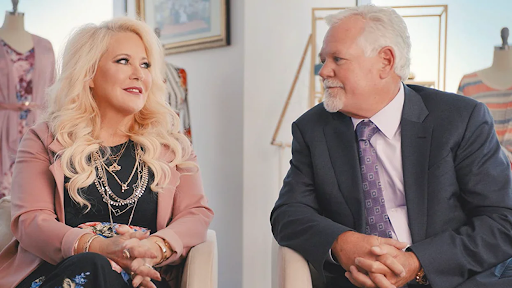Miniseries Review: LuLaRich

Image Courtesy of Amazon Prime Video
By Dean Robbins
The world of multi-level marketing companies has recently become a subject of interest and scrutiny by the general public. YouTube channels like iiluminaughtii that cover these businesses garner millions of views. Especially within certain strata of American suburban society, companies like Amway, Herbalife, and LuLaRoe are nearly unavoidable. The final company, LuLaRoe, and its dramatic rise and fall is the subject of the new Amazon Prime docuseries LuLaRich.
Multi-level marketing companies are composed of a fleet of salespeople who hawk a variety of products from fitness shakes to clothes. While they make money selling products, the bulk of the pay comes from recruiting other salespeople. At the top of the company or the chain are salespeople who have hundreds or thousands of other salespeople under them. For example, Sally recruits two people who each recruit two more people. Sally now receives commissions on the salespeople of all four people under her, or her “downline,” as companies call it. The downlines can only go so far down as there are just not enough people for that level of exponential growth. At its peak, LuLaRoe had around 100,000 salespeople.
Throughout the miniseries’ four episodes, two opposing narratives of the company are told. The first is that of Mark and DeAnne Stidham, the founders of LuLaRoe, who did an interview for the series. The second is that of dozens of former salespeople and company employees who detail countless accusations of abuse, corruption, and incompetence. The filmmakers are not particularly subtle about where their sympathies lie, but the Stidhams are given quite a bit of time to defend themselves. It ultimately feels fair, which is admirable given the circumstances of the situation, including LuLaRoe pressuring women to get experimental weight loss surgery in Tijuana and creating a cult-like atmosphere of shame and exclusion. Admittedly, many of the salespeople in the miniseries are not as sympathetic themselves.
There is a uniquely upper-middle-class problem of voluntarily investing thousands of dollars to have the slim chance of making money selling low-quality leggings, the company’s main product. Women often invested money in becoming a salesperson behind their significant other’s back and opened credit cards to pay for it, all at the recommendation of the company. The prospect of success was shown off by the small group of people at the top of the sales pyramid who were told to brag about their expensive cars and fashion. Despite ultimately enslaving many women in debt, LuLaRoe pitched the business as an opportunity to be free from the 9 to 5 and work at home, near family.
However, all of this underscores just how desperate many people are for some semblance of community and purpose, as even something as artificial as what LuLaRoe offered. They were drawn in by the promise of an active social life, fancy sales rewards from the company, and the ability to take care of children more. At the end of the day, what attracted women to the company was also a failure of American labor. For even the mere vague possibility of feeling less alienated from one’s job, women were willing to go into debt.
As a docuseries, LuLaRich is made standard issue. Long shots of melancholy victims, often repetitive archival footage, and a revolving door of talking heads. An expert on multi-level marketing companies and a casual but devoted follower of the LuLaRoe scandals accentuate the Stidhams and several former employees and salespeople. If you have seen a Netflix docuseries, especially one on cults or celebrity scandals, nothing in LuLaRich will surprise you on a technical or structural level.
LuLaRich ends with the fact that taking down LuLaRoe is like beheading the hydra—one head falls and two more grow. The problem is not just LuLaRoe and not even just the world of MLM companies—it is a fundamental decay at the root of American society.





